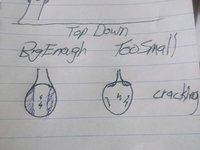sorce
Nonsense Rascal
I'd like to make this a part of our everyday bonsai vocabulary, the difference between an Aesthetic cut, and a Horticultural one.
Stumbled across this while pondering the following for @CrisisM0de in regards to his Amur Clump.
I hope to provoke an in depth conversation, with pictures, about how and when to make cuts.
Many of you know Smoke gave us this idea of a "safety cut". Which I love because it encompasses both patience, and learning, with material in your yard. That is an excellent path to bonsai, it is, bonsai.
The Safety cut is an example of a Horticultural cut.
An Aesthetic cut will be one which defines the silhouette of a tree. Such as these final angled cuts.
Everything has its place, but everywhere possible, I believe this is the best path to most surely creating aesthetically pleasing taper transitions. It begins with understanding the difference between these cuts.
This is applicable to a branch as well as a trunk.
Rather than "blind chopping", or chopping back to just buds, or making a perpendicular cut as we are usually instructed (which is like a safety cut with a short fuse), I believe we should make safety cuts to promote branching, which are safer to cut back to. Safer and more aesthetically pleasing.
This is the result of what I will further refer to as wrong, though everything has its place.

With a perpendicular cut to a bud, we light the short fuse to splitting (cracking rotting etc) beyond what we wish to be our final aesthetically pleasing silhouette line.
By the time cut 2 , our Aesthetic Cut is made, the following illustrates why we have Reverse Taper.
, our Aesthetic Cut is made, the following illustrates why we have Reverse Taper.

With the stub left there, the healing tissue has nowhere to move inward, so it bulges outward. Certain species compartmentalize differently, this must be observed and considered.
To prevent that, this technique can be utilized.

Above we make a safety cut, a Horticultural cut. Allowing our bud to become a branch of size enough to properly heal the wound. We then make one proper Aesthetic Cut there.
For a wound to heal at all, there simply must be enough mass above to continue sap flow around the wound, not just from the front end.

Every tree will certainly react a bit different, this should be observed, on safety cuts . You will find the balance of how large a branch needs to be to successfully heal it. This can range from nothing at all, just a blind cut, to a branch near as thick as the previous segment.
. You will find the balance of how large a branch needs to be to successfully heal it. This can range from nothing at all, just a blind cut, to a branch near as thick as the previous segment.
Cutting a trunk back to get it in a vehicle is a Horticultural Cut.
Hedge Pruning is Horticultural.
The Winter detailing is Aesthetic.
Removing a layer is a Horticultural cut.
Removing the stub off the bottom is Aesthetic.
Important Community First note.
We all practice so vastly different, some of us may never use one or the other of these cuts, yet we are all still practicing bonsai.
Resorce.
Sorce
Stumbled across this while pondering the following for @CrisisM0de in regards to his Amur Clump.
I hope to provoke an in depth conversation, with pictures, about how and when to make cuts.
Many of you know Smoke gave us this idea of a "safety cut". Which I love because it encompasses both patience, and learning, with material in your yard. That is an excellent path to bonsai, it is, bonsai.
The Safety cut is an example of a Horticultural cut.
An Aesthetic cut will be one which defines the silhouette of a tree. Such as these final angled cuts.
Everything has its place, but everywhere possible, I believe this is the best path to most surely creating aesthetically pleasing taper transitions. It begins with understanding the difference between these cuts.
This is applicable to a branch as well as a trunk.
Rather than "blind chopping", or chopping back to just buds, or making a perpendicular cut as we are usually instructed (which is like a safety cut with a short fuse), I believe we should make safety cuts to promote branching, which are safer to cut back to. Safer and more aesthetically pleasing.
This is the result of what I will further refer to as wrong, though everything has its place.

With a perpendicular cut to a bud, we light the short fuse to splitting (cracking rotting etc) beyond what we wish to be our final aesthetically pleasing silhouette line.
By the time cut 2

With the stub left there, the healing tissue has nowhere to move inward, so it bulges outward. Certain species compartmentalize differently, this must be observed and considered.
To prevent that, this technique can be utilized.

Above we make a safety cut, a Horticultural cut. Allowing our bud to become a branch of size enough to properly heal the wound. We then make one proper Aesthetic Cut there.
For a wound to heal at all, there simply must be enough mass above to continue sap flow around the wound, not just from the front end.

Every tree will certainly react a bit different, this should be observed, on safety cuts
Cutting a trunk back to get it in a vehicle is a Horticultural Cut.
Hedge Pruning is Horticultural.
The Winter detailing is Aesthetic.
Removing a layer is a Horticultural cut.
Removing the stub off the bottom is Aesthetic.
Important Community First note.
We all practice so vastly different, some of us may never use one or the other of these cuts, yet we are all still practicing bonsai.
Resorce.
Sorce
